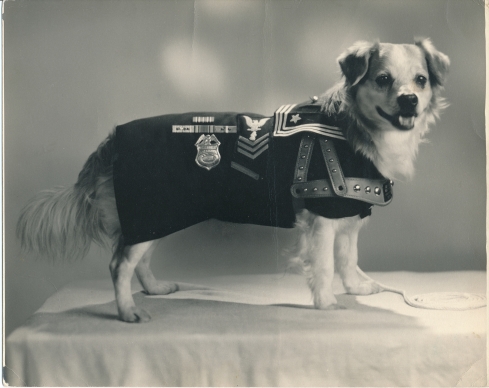

(Captain John McCrea reading on the bridge of Iowa in 1944; me sitting in the same place in 2017.)
In late September 2017, my husband and I flew west from New York City to pay a visit to USS Iowa, now a museum ship in San Pedro, CA, the port of Los Angeles. David Way, the ship’s curator, had invited me to give a talk about Captain McCrea’s War in the ship’s wardroom and to have a guided tour of the ship. This was my first real introduction to the ship. I was joined on this adventure by a few enthusiastic John McCrea fans: a cousin from Boston and a former neighbor now in Oregon, who had both known John personally; and a few others who had come to know him through his memoir.
Dave Way met us on the pier at the aft gangway. Bubbling with enthusiasm and overflowing with knowledge about the ship and its history, Dave led us on a remarkable 3-hour tour from bow to stern, from the tops to deep within the ship. Coming to Iowa from different perspectives, Dave and I each had WW II/McCrea tales to tell, and we had many interesting and humorous exchanges.
Dave showed us to a number of parts of the ship that I had heard much about: the captain’s in port cabin occupied by FDR when John had transported the president and the Joint Chiefs to North Africa in late 1943; the special bathtub installed for FDR in the captain’s bathroom; the 16″ gun turrets and 5” gun mounts; the flag bridge; and the navigation bridge with its heavily armored wheel house (“citadel”) and the enclosure for navigation operations. A sharp-eyed friend pointed out where John had been photographed reading on the bridge in 1944, so I had my photo taken there, too–73 years later. It was a thrill!
Everywhere, I was impressed by the engineering that went into making Iowa a mighty fighting ship: the tubes through which shells were lifted from magazines deep below decks to the guns many levels above; the guns; a sophisticated post-WW II communications room; machinery for raising and lowering the anchors; and tomahawk missiles, another post-WW II development that replaced the old anti-aircraft guns. We also visited venues that reflected the daily lives of the crew: the mess hall and bakery; the claustrophobic bunks used by enlisted men; the hallway leading to the officers’ quarters; and a rather dismal dental office.
You may be surprised to learn that my first impression of Iowa was how small she was. We had spent the previous night on the Queen Mary in neighboring Long Beach, and in comparison to the Queen, Iowa seemed like a toy. But once on board, that impression faded fast. The decks were vast, and the guns enormous. Moreover, our tour, which took us up and down many steep stairways and over multiple high door jambs, proved to be a workout worthy of a gym. It left us with a hard-earned appreciation of the substantial size of Iowa.
After a much needed lunch break, I gave an illustrated book talk in the officers’ wardroom to a group of Iowa museum volunteers and members of the Pacific Battleship Center, which operates the ship. In the discussions afterward, I had the sense that John McCrea is still fondly remembered in Iowa so many years after he served as first commanding officer. One volunteer tour guide, who brought his copy of the memoir for me to sign, remarked how much he enjoyed John (presumably from the book) and how he spoke of him often on his tours. Another palpable presence from the McCrea era is Vicky, the family dog John brought aboard in 1943, and who became the ship’s beloved mascot throughout WW II. Photos of Vicky in his official uniform are posted everywhere as part of a game for young Iowa visitors.
(Dave Way and me after my talk; Vicky, short for “victory,” in his official uniform as Mascot First Class of Iowa.)
As I descended Iowa’s gangway that afternoon, I felt a new appreciation of the might and technological resources of the ship. More important, I was impressed by the warmth of the connection between those who work on the ship today and John. I had a sense of the esprit de corps that John was able to generate when he was commanding officer, and I understood the pride his men must have felt in their ship and in their ability to operate her. It had been a memorable and moving day on Iowa, the first of the four largest battleships ever built by the United States.


sounds like a spectacular visit & love the pics…
LikeLike